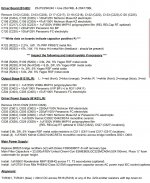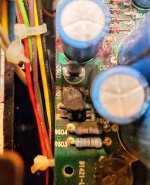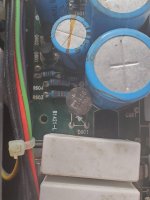I'm not looking series 6 up, but 20000 ohms/volt dc 5000 ohms/volt ac is fine for working anything in the power amp. Earphone jack of radio will drive that without any boost from the input transistor or op amp. Try to get 2 vac scale, handy for front end. Mine has that. 10 vac or 20 vac scale adequate I guess.Okay, you kind of lost me in this section. I'm looking at the Simpson meter you have but cant find much about it. Do you know if it's similar to a Simpson 260 series 6? I can get one of those local from someone asking $75.
You'll spend a lot of time with the dvm fixing blown stuff and getting DC voltage stable and in the middle of the rails before you ever go chasing music that stops. I've had some bad solder joints in Peavey hand built products (as well as my own non-pro solder jobs) and music sometimes stops, sometimes goes on those dodgy but good looking joints. Poking around with meter tip can make them connect or mess up.
Thanks for compliments. I get these things playing music again without a lot of fancy test gear. May need better equipment for new designs. I just copy the schematics of proven ones, mostly apex. Although now my passion is broken peavey gear; ugly, cheap, reviled, sounds pretty good post 1990. Last bargain ($15) shows case damage from the trip to the dumpster. Looks like the canister of a vacuum cleaner inside. Laugh emogi. No transformer stink.
Last edited:
My Goodness ! Look at the number of those 0,1uF in the power supply. They're choking the heck out of the power supply.
You can freely pull out almost all of them. The amplifier will thank you. 🙂
My Goodness ! Look at the number of those 0,1uF in the power supply. They're choking the heck out of the power supply.
You can freely pull out almost all of them. The amplifier will thank you. 🙂
Theres some write ups online that talk about doing that....based on some John Curl comments.... here is a write up about it.... whatishifi: Restoring and modifing a Parasound HCA-2200II power amp.
But attached is a mod writeup from Big Sky Audio, after he retired he posted what his modifications were. But I dont yet know enough about all this to tell if the web link how to and this attached document are the same or not....
Attachments
Speaking of the modifications themselves....I've been researching the parts in this document that Big Sky Audio released after closing shop and it seems like some are hard to source, especially the ones listed at the top...SJ74BL and 2SK170
Attachments
Yep, 2SK170/2SJ74 are impossible to find. Epay/AliExpress/Alibaba are drowning in fake transistors. Linear Integrated Systems are manufacturing LSK170/LSJ74. You can buy directly from Linear Integrated Systems and Digikey or from diyAudio store, matched but a bit pricey. 😱
I'm not so convinced that pricey "audio" Muse electrolytic caps are better than the top industrial grades from Panasonic, Nichicon, Rubicon, Vishay. Once you get into the 3000 to 10000 hour service life grade you have eliminated the cost cutter caps.
I am convinced that polyprophylene film caps are more linear than mylar or polyester. There are different brands available today. People here swear by wima but they are hard to find in the USA. One boutique distributor I believe I saw. I just bought some .047 uf kemet brand PP for my AX6 project.
I am convinced COG ceramic caps sound okay as coupler caps. 50 v or 100 v grade should be more linear on 2 v signals. I use 2.2 uf ceramics as input caps instead of death prone NP electrolytics on my projects. Bought some 22 uf NP caps today; none was rated higher than 2000 hr @ 85 C which is probably the grade I've found so bassless in 1990 amps I've repaired.
I am convinced that metal film resistors sound better in the 100k up values than carbon composition. I did that myself to my dynakit ST70, with obvious hiss improvement. I'm not sure that resistances under 100k have as an obvious audible difference. Metal oxide is very pricey, still available but I'm not sure difference to metal film is worth the money. Some people test amps for linearity & stability into the 1-5 mhz range. This is not IMHO audible to humans - maybe mice. Metal film resistors are a wound trace, which adds a little inductance which may have to be designed around in radio frequency circuits.
A soft recovery bridge rectifier may require less filtering to avoid the sharp shutoff edges creeping into the sound at 120 hz. The reason why "premium" fast recovery or ultra fast is not the thing. Faster shutoff is better for television or UHF radio circuits, not for power rectifiers. The filter is a cheap old ceramic .01 uf cap X7R dielectric series a cheap 1/4 watt resistor. Regular diode bridges are slow enough IMHO with a filter added across the output. The bridge filter has to be local though, you don't want to be transmitting sharp cutoff edges through 6" wires to a daughter board or something. Look up fourier transform for the RF components of a vertical voltage edge.
Look carefully at the op amp in the circuit. There have been a lot of improvements in op amps since 198? . The better ones can cost $.38 . You may have to add feedback resistor bypass caps and local +-15 v bypass caps to eliminate oscillation of modern parts, but it was really worth it in one project I did. Replaced hissy 50x gain 4558's with st33078's which were the price quoted. Much less hiss.
Nope none of your jfets or dual jfets are blown. At least the jfets installed are n channel, which you might have a hope of finding a replacement under a different number. Duals? Especially with leads. Good luck on that.
I am convinced that polyprophylene film caps are more linear than mylar or polyester. There are different brands available today. People here swear by wima but they are hard to find in the USA. One boutique distributor I believe I saw. I just bought some .047 uf kemet brand PP for my AX6 project.
I am convinced COG ceramic caps sound okay as coupler caps. 50 v or 100 v grade should be more linear on 2 v signals. I use 2.2 uf ceramics as input caps instead of death prone NP electrolytics on my projects. Bought some 22 uf NP caps today; none was rated higher than 2000 hr @ 85 C which is probably the grade I've found so bassless in 1990 amps I've repaired.
I am convinced that metal film resistors sound better in the 100k up values than carbon composition. I did that myself to my dynakit ST70, with obvious hiss improvement. I'm not sure that resistances under 100k have as an obvious audible difference. Metal oxide is very pricey, still available but I'm not sure difference to metal film is worth the money. Some people test amps for linearity & stability into the 1-5 mhz range. This is not IMHO audible to humans - maybe mice. Metal film resistors are a wound trace, which adds a little inductance which may have to be designed around in radio frequency circuits.
A soft recovery bridge rectifier may require less filtering to avoid the sharp shutoff edges creeping into the sound at 120 hz. The reason why "premium" fast recovery or ultra fast is not the thing. Faster shutoff is better for television or UHF radio circuits, not for power rectifiers. The filter is a cheap old ceramic .01 uf cap X7R dielectric series a cheap 1/4 watt resistor. Regular diode bridges are slow enough IMHO with a filter added across the output. The bridge filter has to be local though, you don't want to be transmitting sharp cutoff edges through 6" wires to a daughter board or something. Look up fourier transform for the RF components of a vertical voltage edge.
Look carefully at the op amp in the circuit. There have been a lot of improvements in op amps since 198? . The better ones can cost $.38 . You may have to add feedback resistor bypass caps and local +-15 v bypass caps to eliminate oscillation of modern parts, but it was really worth it in one project I did. Replaced hissy 50x gain 4558's with st33078's which were the price quoted. Much less hiss.
Nope none of your jfets or dual jfets are blown. At least the jfets installed are n channel, which you might have a hope of finding a replacement under a different number. Duals? Especially with leads. Good luck on that.
Last edited:
@indianajo @HighTec
What do you guys think about that document switching the main caps to 22,000uf/80v United Chemi-Con? The original caps are 25,000uf. Would it be better to go with a different cap that is 25,000uf? If so....do you guys have suggestions? I'm not sure what the best brands are...
Thank You so much for all that info above, itll help greatly as I'm not sure what all to buy! REALLY appreciate it!
What do you guys think about that document switching the main caps to 22,000uf/80v United Chemi-Con? The original caps are 25,000uf. Would it be better to go with a different cap that is 25,000uf? If so....do you guys have suggestions? I'm not sure what the best brands are...
Thank You so much for all that info above, itll help greatly as I'm not sure what all to buy! REALLY appreciate it!
I wouldn't switch the mains cap unless it has high ESR. There are ESR meters but the cheapest way to test is check amp for full watts performance after it is fixed. Not enough watts, main cap is dried up. You will pay a huge premium to get 25000 uf instead of 22000 uf. They old numbers are gone.
Brands of cap don't matter to me as much as service life. I replaced mains cap 4 times in my ST70 since 1970, much too much work. Now you can buy 5000 or 10000 hours caps at distributors like newark, digikey, mouser. Mouser won't tell you the service life, you have to download the datasheet & read it. The premium brands electrolytics IMHO are Panasonic, Nichicon, Rubicon, Vishay, Kemet. I've seen a lot of nichicons in industrial motor drives that live in 140 deg F oven drive compartments, where they last a decade. All the above make a 1000 hour cap for people who believe in cheaper parts. (like most repair shops).
As far a muse, there may be special construction but you can improve high freq performance of a large electrolytic cap by paralleling it with a 1 to 2.2 uf film cap. Doesn't always work, sometimes causes ultrasonic oscillation, but installing one parallel to rail cap is a $1 experiment. Peavey did it in my PV-1.3k amps. two .47 uf caps parallel to the rail right on the output transistor board, and 8" away from the 10000 uf main rail caps. You've got all those .01 uf film caps parallel the 25000 uf caps, an attempt at the same thing. One 1 uf per rail for $.50 could replace all those. 1 uf film doesn't cost now like it did in 198?. You can even get stacked film caps now which have even lower inductance than wound ones. Inductance makes high frequency current demand slow down.
Really, get a DVM and start checking for blown parts first before you try to upgrade the amp. Blown rail fuses is a sign of a typical meltdown caused by shorted speaker wire or a shorted turn in a woofer. You may find some blown but unobtainable dual jfets or something, and find your new rail caps were a total waste of money. Hopefully the melt down stopped at the drivers or predrivers. Don't forget to check the resistors in the OT area.
I had to put 145 parts in the PV-1.3k. Not economic, but I learned a lot about the function of all those parts while crawling through the amp. Lots of salvage diodes & resistors in there, I didn't buy everything new. This parasound with 7 pairs output transistors puts it in the same wattage class. Actually, not a good amp to start with. A 100 w/ch PV-4c or rotel something would help you build your skills without blowing parts to the ceiling with +-80 v rails.
Brands of cap don't matter to me as much as service life. I replaced mains cap 4 times in my ST70 since 1970, much too much work. Now you can buy 5000 or 10000 hours caps at distributors like newark, digikey, mouser. Mouser won't tell you the service life, you have to download the datasheet & read it. The premium brands electrolytics IMHO are Panasonic, Nichicon, Rubicon, Vishay, Kemet. I've seen a lot of nichicons in industrial motor drives that live in 140 deg F oven drive compartments, where they last a decade. All the above make a 1000 hour cap for people who believe in cheaper parts. (like most repair shops).
As far a muse, there may be special construction but you can improve high freq performance of a large electrolytic cap by paralleling it with a 1 to 2.2 uf film cap. Doesn't always work, sometimes causes ultrasonic oscillation, but installing one parallel to rail cap is a $1 experiment. Peavey did it in my PV-1.3k amps. two .47 uf caps parallel to the rail right on the output transistor board, and 8" away from the 10000 uf main rail caps. You've got all those .01 uf film caps parallel the 25000 uf caps, an attempt at the same thing. One 1 uf per rail for $.50 could replace all those. 1 uf film doesn't cost now like it did in 198?. You can even get stacked film caps now which have even lower inductance than wound ones. Inductance makes high frequency current demand slow down.
Really, get a DVM and start checking for blown parts first before you try to upgrade the amp. Blown rail fuses is a sign of a typical meltdown caused by shorted speaker wire or a shorted turn in a woofer. You may find some blown but unobtainable dual jfets or something, and find your new rail caps were a total waste of money. Hopefully the melt down stopped at the drivers or predrivers. Don't forget to check the resistors in the OT area.
I had to put 145 parts in the PV-1.3k. Not economic, but I learned a lot about the function of all those parts while crawling through the amp. Lots of salvage diodes & resistors in there, I didn't buy everything new. This parasound with 7 pairs output transistors puts it in the same wattage class. Actually, not a good amp to start with. A 100 w/ch PV-4c or rotel something would help you build your skills without blowing parts to the ceiling with +-80 v rails.
Last edited:
The difference between 22,000 uF and 25,000 uF isn't enough to make a noticeable difference. Keep in mind that most electrolytics have a +/- 20% tolerance, and the exact value of the filter caps is extremely non-critical. You could increase or decrease their size by 50% without noticing much difference.
Panasonic, Rubycon and United Chemi-Con are my first choices for cap brands, and usually I end up with UCC for things like screw-terminal caps.
Kemet, Vishay, Epcos, Nichicon and TDK also make good caps, I just have had the best luck with the above three when it comes to reliability.
Panasonic, Rubycon and United Chemi-Con are my first choices for cap brands, and usually I end up with UCC for things like screw-terminal caps.
Kemet, Vishay, Epcos, Nichicon and TDK also make good caps, I just have had the best luck with the above three when it comes to reliability.
options for re-build
When (re)building, you have to balance what you can get with what will actually fit. Not all people have the budgets or access to these parts, by virtue may be overtly dismissive of many "name brand parts" by the lack of direct experience.
I have considerable experience with the UCC brand caps, heavily used in "Hafler 500 - 600 amp" builds. *Regardless* of listed numbers, they are quite reliable and have very long life. UCC are/have been used in (many great products) the Levinson 3 series amps and in Goldmund Products. I heavily recommend the United Chemi-Con or Nichicon Gold Tunes.
I have considerable experience with the entire Nichicon MUSE line, *they are not over-rated* I stock / have on hand nearly every value... they have slowly displaced the Nichicon Fine Golds... both of which I heavily favored over the Elna Silmic II (which are soft, pleasing, but ommissive) The MUSE NP electrolytics are difficult to beat...
Another favorite of mine is the WIMA brand, (READILY available, at Mouser) I stock nearly every value and lead spacing, making for very tidy equipment updates. The Wima PP caps may be among the most neutral film caps available. Being stacked metal films, they have low inductance, a high [broad] frequency balance and neutrality (that word again) are perhaps the best film capacitor for bypassing PS caps. They are very affordable, should not considered a *boutique cap*. Wima caps are found in everything... are "not cheap caps", by the scale of economy, they have been made affordable.
When (re)building, you have to balance what you can get with what will actually fit. Not all people have the budgets or access to these parts, by virtue may be overtly dismissive of many "name brand parts" by the lack of direct experience.
I have considerable experience with the UCC brand caps, heavily used in "Hafler 500 - 600 amp" builds. *Regardless* of listed numbers, they are quite reliable and have very long life. UCC are/have been used in (many great products) the Levinson 3 series amps and in Goldmund Products. I heavily recommend the United Chemi-Con or Nichicon Gold Tunes.
I have considerable experience with the entire Nichicon MUSE line, *they are not over-rated* I stock / have on hand nearly every value... they have slowly displaced the Nichicon Fine Golds... both of which I heavily favored over the Elna Silmic II (which are soft, pleasing, but ommissive) The MUSE NP electrolytics are difficult to beat...
Another favorite of mine is the WIMA brand, (READILY available, at Mouser) I stock nearly every value and lead spacing, making for very tidy equipment updates. The Wima PP caps may be among the most neutral film caps available. Being stacked metal films, they have low inductance, a high [broad] frequency balance and neutrality (that word again) are perhaps the best film capacitor for bypassing PS caps. They are very affordable, should not considered a *boutique cap*. Wima caps are found in everything... are "not cheap caps", by the scale of economy, they have been made affordable.
Attachments
Last edited:
reluctance to replace OEM parts 6/6
A DIY'er was reluctant to use the same (OEM) brand of cap in his amp, as the same ones/brand that failed... after 20 years. I sort of "get it"... What is a person going / able to do? Replacing a worn out 20 year old part.
Caps like tires are the *expendables*, especially the main PS caps savaged by AC Ripple (doing their jobs) over a lifetime, with the entire musical experience riding on them. Think about it, the naysayers get brain spams trying to...
I get less that 10,000 miles on a set of rear Michelin Pilot Sports with a 5.5 liter V8 powering them. The service writer at the dealership, once laughed and told me he gets even less on his.
A DIY'er was reluctant to use the same (OEM) brand of cap in his amp, as the same ones/brand that failed... after 20 years. I sort of "get it"... What is a person going / able to do? Replacing a worn out 20 year old part.
Caps like tires are the *expendables*, especially the main PS caps savaged by AC Ripple (doing their jobs) over a lifetime, with the entire musical experience riding on them. Think about it, the naysayers get brain spams trying to...
I get less that 10,000 miles on a set of rear Michelin Pilot Sports with a 5.5 liter V8 powering them. The service writer at the dealership, once laughed and told me he gets even less on his.
As far a muse, there may be special construction but you can improve high freq performance of a large electrolytic cap by paralleling it with a 1 to 2.2 uf film cap. Doesn't always work, sometimes causes ultrasonic oscillation, but installing one parallel to rail cap is a $1 experiment. Peavey did it in my PV-1.3k amps. two .47 uf caps parallel to the rail right on the output transistor board, and 8" away from the 10000 uf main rail caps. You've got all those .01 uf film caps parallel the 25000 uf caps, an attempt at the same thing. One 1 uf per rail for $.50 could replace all those. 1 uf film doesn't cost now like it did in 198?. You can even get stacked film caps now which have even lower inductance than wound ones. Inductance makes high frequency current demand slow down.
Really, get a DVM and start checking for blown parts first before you try to upgrade the amp. Blown rail fuses is a sign of a typical meltdown caused by shorted speaker wire or a shorted turn in a woofer. You may find some blown but unobtainable dual jfets or something, and find your new rail caps were a total waste of money.
How would one test for ultrasonic oscillation? Is it something you will notice just by listening?
I didnt realize in a 90's amp there are parts that if bad, are not replaceable. I figured pretty much everything from the 90's is replaceable/repairable. Well then, I will certainly get the amp healthy first. I guess my plan was too repair and modify at the same time because it seems like many of the parts the modification replaces are potentially bad in my amp. So was thinking I'd go ahead and buy everything.....but in retrospect I'll just buy whatever it takes to repair so I can make sure it's good before buying a lot of expensive stuff like the main caps.
Thank You!
Last edited:
Here comes the newbie/dummy questions....so on this board where its crisp, are the small blue things resistors? What is the taller black thing?
There are two of the blue things that are all crispy right next to the tall crispy black one, I'm thinking I should replace all those no matter how they test, just to make sure they are healthy. But I'm not sure how to go about finding these online. I see them on the schematic but theres no part number.
There are two of the blue things that are all crispy right next to the tall crispy black one, I'm thinking I should replace all those no matter how they test, just to make sure they are healthy. But I'm not sure how to go about finding these online. I see them on the schematic but theres no part number.
Attachments
See post 114 for how to detect ultrasonic oscillation with a $14 analog VOM. you see a steady ac voltage, don't hear any music out, don't see the beats of rock music making the pointer wave around, you've likely got ultrasonic oscillation. You can prove it by replacing the .047 uf blocking capacitor with a 390 pf one. Still the same voltage, it is ultrasonic. Music will not go through a 390 pf cap. Capacitors block lower frequencies.
I would wash those contaminated parts with 409 or scrubbing bubbles or something & a paper towel, followed by a water rinse. They have plastic cases, they are probably fine inside. I can't find that B1241 coil on the schematic, but you can't duplicate it unless you measure it with a lot of tools. BR525 was a power transformer, so they are using B for inductors. The schematic you posted has no RF blocking inductors between the output jacks & the output disconnect relays. Since 1980 everybody now is carrying a radio, which can drive amps crazy coming in from the speaker wires. 14 turns 14 ga magnet wire wound around a kiddie pencil or 3/8" wooden dowel is the usual solution to keeping the RF out of an amp. I added one to an Allen S100 amp that was picking up sports talk AM radio in the church service. Wound around a 3 ohm 5 w resistor wired in parallel. Parasound may have inserted the output inductor after the initial version caused a lot of warranty work.
I would wash those contaminated parts with 409 or scrubbing bubbles or something & a paper towel, followed by a water rinse. They have plastic cases, they are probably fine inside. I can't find that B1241 coil on the schematic, but you can't duplicate it unless you measure it with a lot of tools. BR525 was a power transformer, so they are using B for inductors. The schematic you posted has no RF blocking inductors between the output jacks & the output disconnect relays. Since 1980 everybody now is carrying a radio, which can drive amps crazy coming in from the speaker wires. 14 turns 14 ga magnet wire wound around a kiddie pencil or 3/8" wooden dowel is the usual solution to keeping the RF out of an amp. I added one to an Allen S100 amp that was picking up sports talk AM radio in the church service. Wound around a 3 ohm 5 w resistor wired in parallel. Parasound may have inserted the output inductor after the initial version caused a lot of warranty work.
Last edited:
See post 114 for how to detect ultrasonic oscillation with a $14 analog VOM. you see a steady ac voltage, don't hear any music out, don't see the beats of rock music making the pointer wave around, you've likely got ultrasonic oscillation. You can prove it by replacing the .047 uf blocking capacitor with a 390 pf one. Still the same voltage, it is ultrasonic. Music will not go through a 390 pf cap. Capacitors block lower frequencies.
I would wash those contaminated parts with 409 or scrubbing bubbles or something & a paper towel, followed by a water rinse. They have plastic cases, they are probably fine inside. I can't find that B1241 coil on the schematic, but you can't duplicate it unless you measure it with a lot of tools. BR525 was a power transformer, so they are using B for inductors. The schematic you posted has no RF blocking inductors between the output jacks & the output disconnect relays. Since 1980 everybody now is carrying a radio, which can drive amps crazy coming in from the speaker wires. 14 turns 14 ga magnet wire wound around a kiddie pencil or 3/8" wooden dowel is the usual solution to keeping the RF out of an amp. I added one to an Allen S100 amp that was picking up sports talk AM radio in the church service. Wound around a 3 ohm 5 w resistor wired in parallel. Parasound may have inserted the output inductor after the initial version caused a lot of warranty work.
I *think* that B1421-L is the number for the entire board. On the other side its labeled B1421-R. I attached a better picture of that area from the other amp that isnt damaged there.
So can I just pull this board out and clean the entire board with 409 or just remove those specific parts and only clean them with 409? I wouldnt think I can rinse the board with water can I? I do have some 99% isopropyl alcohol. The entire amp needs a good cleaning inside.
Attachments
Last edited:
Well yes, 70% isoprophyl alcohol is another fluid I use on contaminated boards. Paper towels generally, cotton balls for gentle scrubbing. A little water rinse won't hurt microelectronics if you let it sit a couple of days in low humidity to dry it off. A co-worker used to steam clean Intel multibus computers that had factory grease all over them. The same steam cleaner the maintenance workers used on motors gearboxes & the like. Then he would put them in an environmental chamber at 120 deg F for several hours to dry them.
I wouldn't remove those parts, just clean them. Cap slime can eat through pcb lands if left on there long enough in a coastal or wet environment. Was the previous owner near the sea?
I wouldn't remove those parts, just clean them. Cap slime can eat through pcb lands if left on there long enough in a coastal or wet environment. Was the previous owner near the sea?
Last edited:
Are you absolutely sure it’s cap slime and not just glue? If it’s completely hardened, and nearby metal is showing no signs of corrosion it’s usually glue to keep from getting stress on the cap’s leads.
Well yes, 70% isoprophyl alcohol is another fluid I use on contaminated boards. Paper towels generally, cotton balls for gentle scrubbing. A little water rinse won't hurt microelectronics if you let it sit a couple of days in low humidity to dry it off. A co-worker used to steam clean Intel multibus computers that had factory grease all over them. The same steam cleaner the maintenance workers used on motors gearboxes & the like. Then he would put them in an environmental chamber at 120 deg F for several hours to dry them.
I wouldn't remove those parts, just clean them. Cap slime can eat through pcb lands if left on there long enough in a coastal or wet environment. Was the previous owner near the sea?
Yes actually! I picked them up in Mobile, AL right on the coast. Will the alcohol or 409 clean off the cap slime well? Hopefully it hasnt eaten through anything!
I do high end car detail and paint correction so I have a steamer and also very very gentle brushes. I also have some very gentle cleaners that dont leave residue. So it sounds like it's fine to clean these boards thoroughly and even use water and/or steam....I just need to make sure they are very dry before using them. Maybe a hair dryer held a foot or so back would be good to dry?
I pulled the board out and took better pictures of the damaged area....but the amp still turns on, no protection, and plays.
Attachments
-
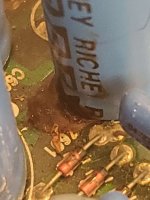 Compress_20211116_122850_0950.jpg151.2 KB · Views: 85
Compress_20211116_122850_0950.jpg151.2 KB · Views: 85 -
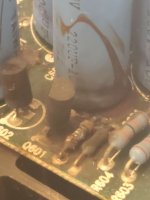 Compress_20211116_122850_0768.jpg84.8 KB · Views: 96
Compress_20211116_122850_0768.jpg84.8 KB · Views: 96 -
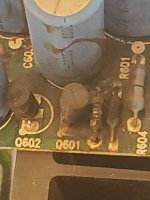 Compress_20211116_122850_0620.jpg145.3 KB · Views: 99
Compress_20211116_122850_0620.jpg145.3 KB · Views: 99 -
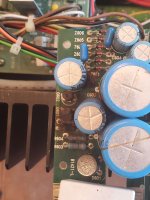 Compress_20211116_122850_0428.jpg198.8 KB · Views: 115
Compress_20211116_122850_0428.jpg198.8 KB · Views: 115 -
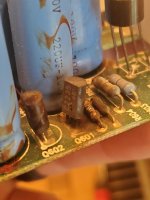 Compress_20211116_123937_7581.jpg485.1 KB · Views: 95
Compress_20211116_123937_7581.jpg485.1 KB · Views: 95 -
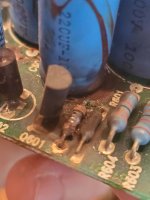 Compress_20211116_123936_6648.jpg395.3 KB · Views: 88
Compress_20211116_123936_6648.jpg395.3 KB · Views: 88
Last edited:
If the brown stuff washes off, it can be cap slime. If it stays put & becomes smoother lookiing, it is hot melt glue. Or possible rubber adhesive, a cool substance now banned by the California Air Board. *&^%# Liquid Nails adhesive is now water based and about as strong as sheep manure.
Last edited:
- Home
- Amplifiers
- Solid State
- Is a Parasound HCA-2200ii still reliable?
